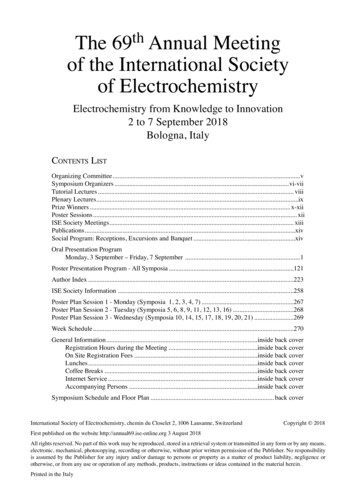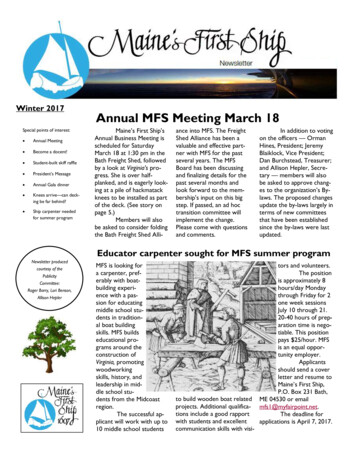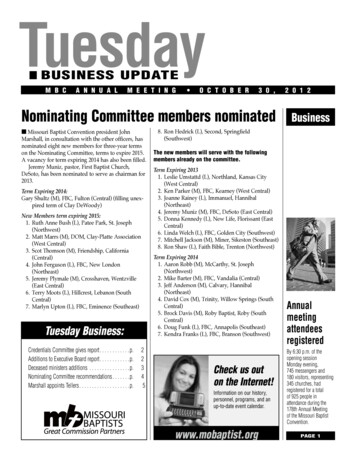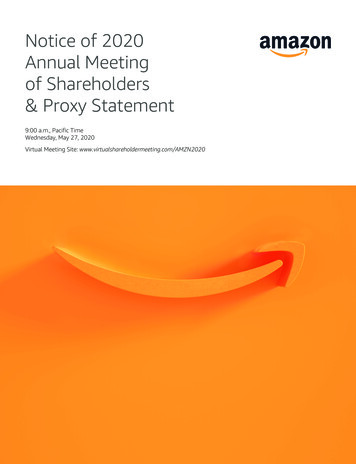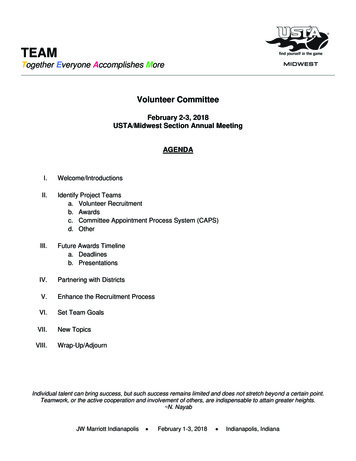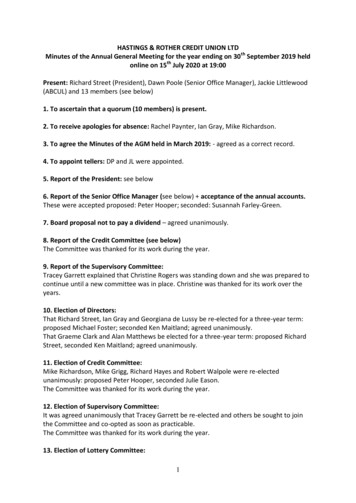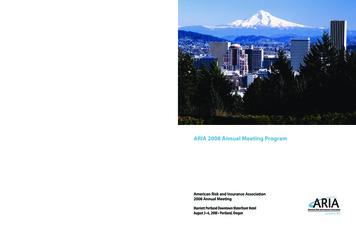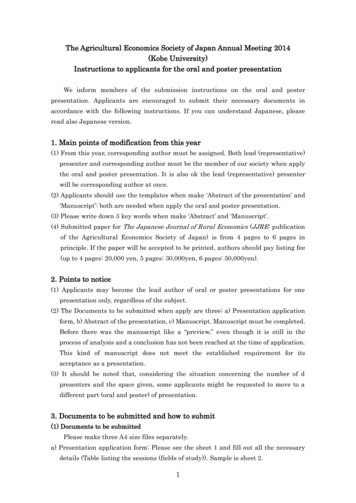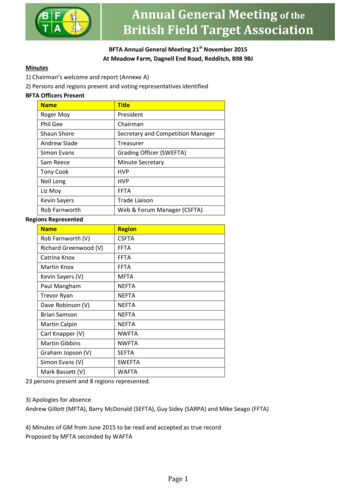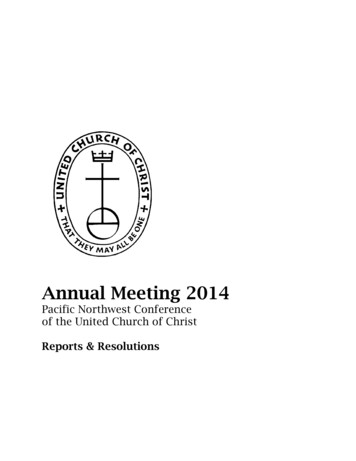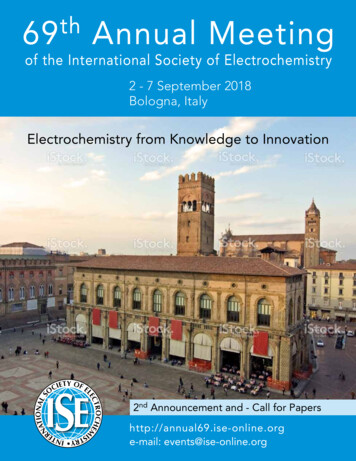
Transcription
th69Annual Meetingof the International Society of Electrochemistry2 - 7 September 2018Bologna, ItalyElectrochemistry from Knowledge to InnovationELROCHEMTIONALSNATY OFTECOCIE2nd Announcement and - Call for Papershttp://annual69.ise-online.orge-mail: events@ise-online.org Den Haag Marketing TRY INTERIS
TY OFELROCHEMTIONALSNACIETECO69th Annual Meeting of the International Society of Electrochemistry TRY INTERISOrganizing CommitteePlamen Atanassov, Albuquerque, NM, USAPhilip N. Bartlett, Southampton, UKSalvatore Daniele, Venezia, ItalyFrancesco Di Quarto, Palermo, ItalyKatharina Krischer, Munich, GermanyTomokazu Matsue, Sendai, JapanMarco Musiani, Padova, Italy (co-chair)Francesco Paolucci, Bologna, Italy (co-chair)Sandra Rondinini, Milano, ItalyGunther Wittstock, Oldenburg, GermanyInvitation to ISE 2018You are warmly invited to the 69th Annual ISE Meeting to be held in Bologna, Italy, from 2 to 7September 2018. The meeting will be hosted by the “Nuovo Polo Congressuale Bologna”. Bologna,seat of the oldest university in the western world, has been for centuries the place where academicknowledge is generated and transmitted throughout generations. Now the town is the centre of avibrant, innovation-driven, high-tech area. To mark the continuity between academic culture andtechnological progress, the scientific theme of the meeting is Electrochemistry from Knowledge toInnovation. The scientific program of the 69th Annual Meeting will comprise symposia sponsored byall ISE Divisions, covering all the scientific interests of the ISE membership and of the electrochemicalcommunity at large. Fundamental aspects of analytical, molecular, physical and bioelectrochemistrywill be discussed, as well as their applications to (nano)materials science, energy, environment andbiomedicine.Electrochemistry from Knowledge to Innovation
ELMTIONALSNATY OFROCHE69th Annual Meeting of the International Society of ElectrochemistryCIETECO TRY INTERISSummary of SymposiaSymposium 1:Nanomaterials for Electroanalytical Chemistry and Electroanalytical Tools for StudyingNanomaterialsSymposium 2:Hyphenated-Techniques Incorporating Analytical ElectrochemistrySymposium 3:Bioelectrochemistry Returns to the Home of GalvaniSymposium 4:Bipolar Electrochemistry, from Bioanalysis to Materials ScienceSymposium 5:Photobioelectrochemistry - from Basic Concepts and Materials to DevicesSymposium 6:Batteries into the Future: from Advanced Lithium-Ion Systems to Novel Chemistries andArchitecturesSymposium 7:Electrochemical Systems for Energy Conversion: Fuel Cells and ElectrolysersSymposium 8:Supercapacitors: from Double-Layer Electrochemical Capacitors to Faradaic-Based HighPower SystemsSymposium 9:Photo-Electrochemical Energy Conversion: Symposium in Honor of Prof. Jan AugustynskiSymposium 10:Materials for and from Electrochemistry: State of the Art and Future TrendsSymposium 11:Corrosion, Passivation, and Protection StrategiesSymposium 12:Electrophoretic Deposition of Functional Coatings: from Materials Science toBiotechnologySymposium 13:Electrochemistry Applied to Cultural HeritageSymposium 14:Electrochemical Engineering: Research towards Deployable TechnologySymposium 15:New Trends in (Bio)-Molecular ElectrochemistrySymposium 16:Micro- and Nano-Scale Platforms to Study Electron Transport in (Bio) Molecular Systems:from Fundamentals to Molecular DevicesSymposium 17:Physical Electrochemistry: Recent Developments in Spectroscopy, Microscopy and Theoryfor the Rational Design of Electrochemical InterfacesSymposium 18:Theory: from Understanding to Optimization and PredictionSymposium 19:Single Entity ElectrochemistrySymposium 20:Interfacial Electrochemistry in Non-Aqueous ElectrolytesSymposium 21:General SessionElectrochemistry from Knowledge to Innovation
TY OFELROCHEMTIONALSNACIETECO69th Annual Meeting of the International Society of Electrochemistry TRY INTERIS2017 ISE Prize Winners and Award LecturersFrumkin Memorial MedalFrumkin Memorial MedalBioelectrochemistry Prize of ISE Division 2Doron AurbachDoron Aurbach, Bar Ilan University, IsraelJ, UBrian Conway Prize for Physical ElectrochemistryM, LEarly Career Analytical ElectrochemistryPrize of ISE Division 1K, TISE-Elsevier Prize forExperimental ElectrochemistryN, AISE Prize for ElectrochemicalMaterials ScienceC, PISE Prize for Applied ElectrochemistryS, PISE-Elsevier Prize for Green ElectrochemistryJ, UJaroslav Heyrovsky Prize forMolecular ElectrochemistryI, UTajima PrizeM, UniversityBar Ilan University, IsraelDoron Aurbach is a full professorin the department of Chemistry,leading the electrochemistry group(40 people), a senate member atBar Ilan university (BIU), Israel. Hechaired the department of chemistryduring 2001-2005. He foundedthe electrochemistry group at BIU32 years ago, 50 PhD and 70 MScstudents received their degreesunder his supervision since then.His team studies the electrochemistry of active metals, nonaqueous electrochemical systems, develops spectroscopicmethods (in situ and ex situ) for sensitive electrochemicalsystems, studies electrochemical intercalation processes,electrochemical water desalination, electronically conductingred-ox polymers and develop rechargeable high energydensity batteries and EDL capacitors. D. Aurbach haspublished so far more than 560 peer reviewed papers, morethan 30600 citations, H index of 88 (WOS, mid 2017), 25patents, 19 chapters in books and presented his scientificwork in hundreds of invited talks in international conferences.D. Aurbach is serving as a senior editor in the Journal of theElectrochemical Society (JES). He is a fellow of the ECS(2008), ISE (2010) and MRS (2012). He is the head of INREP:Israel national research center for electrochemical propulsion(founded in 2012, 22 research groups). He received the ECSbattery Div. technology award (2005), the Israel vacuumsociety (IVS) and Israel chemical society (ICS) excellenceprizes (2007, 2012), the Landau prize for research towardsgreen energy (2011), the ECS battery Div. research award,the Kolthoff prize (2013) and the E.B. Yeager prize of theInternational Battery Association IBA (2014) a member of theEuropean Academy (2015), recipient of the A.J. Bard Awardof the ECS in 2017.Oronzio and Niccolò De Nora FoundationYoung Author PrizeL, NElectrochemistry from Knowledge to Innovation
ELMTIONALSNATY OFROCHE69th Annual Meeting of the International Society of ElectrochemistryCIETECO TRY INTERISTutorialsTutorial 1Computational ElectrochemistryRichard G. Compton, Oxford University, UKEnno Kaetelhoen, Oxford University, UKEduardo Laborda, University of Murcia, SpainThe teachers aim to teach students and post-docs to writetheir own programs to simulate voltammetry and otherelectrochemical experiments. The course is not about theusage of off-the-shelf commercial packages. The coursewill be built on the book Understanding Voltammetry:Simulation of Electrode Processes by R.G. Compton, E.Laborda and K.R. Ward, Imperial College Press, 2014.Tutorial 2Differential Electrochemical Mass Spectrometry(DEMS)Helmut Baltruschat, University of Bonn, GermanyZenonas Jusys, University of Ulm, GermanyIt is our intention that students understand how a massspectrometer is best coupled to an electrochemical cell.They should learn what the requirements for the vacuumsystem are, how corresponding electrochemical cellsshould look like and what kind of cell is best suited for whichpurpose. Examples will be treated on how quantitativedata can be gained. Limitations of the method will alsobe discussed.Tutorial 3Impedance Spectroscopy for the Diagnostic ofElectrochemical Energy Storage/ConversionSystemsMark Orazem, University of Florida at Gainesville, USAThis course, based on the recent textbook, ElectrochemicalImpedance Spectroscopy, 2nd Edition, by M.E. Orazem, B.Tribollet, John Wiley & Sons, Hoboken, 2017, is intendedfor chemists, physicists, material scientists, and engineerswith an interest in applying electrochemical impedancetechniques to study a broad variety of electrochemicalprocesses. Attendees will develop an understandingof the technique, how to develop models with physicalsignificance, and how to use graphical and regressionmethods to interpret measurements. Examples will includeaspects of electrochemical energy storage/conversionsystems.Electrochemistry from Knowledge to Innovation
TY OFELROCHEMTIONALSNACIETECO69th Annual Meeting of the International Society of Electrochemistry TRY INTERISPlenary LecturersSteven ChuStanford University, USAShelley MinteerUniversity of Utah, USASteven Chu is the William R. Kenan, Jr., Professor of Physics and Professor of Molecular & Cellular Physiology in the Medical School at Stanford University. He has published over 275 papersin atomic and polymer physics, biophysics, biology, batteries, and holds 11 patents. Currently,he is developing new optical nanoparticle probes for applications in biology and biomedicine,exploring new approaches to lithium ion batteries, PM2.5 air filtration and other applications ofnanotechnology.Dr. Chu was the 12th U.S. Secretary of Energy from January 2009 until the end of April 2013.As the first scientist to hold a c abinet position and the longest serving Energy Secretary, herecruited outstanding scientists and engineers into the Department of Energy. He began severalinitiatives including ARPA-E (Advanced Research Projects Agency – Energy), the Energy Innovation Hubs, the U.S. – China Clean Energy Research Centers (CERC), and was personally tasked byPresident Obama to assist BP in stopping the Deepwater Horizon oil leak.Prior to his cabinet post, he was director of the Lawrence Berkeley National Laboratory and Professor of Physics and Molecular and Cell Biology at UC Berkeley. Previously he was the Theodoreand Francis Geballe Professor of Physics and Applied Physics at Stanford University. He helpedlaunch Bio-X at Stanford University, a multi-disciplinary institute combining the physical and biological sciences with medicine and engineering, and the Kavli Institute for Particle Astrophysicsand Cosmology. Previously he was head of the Quantum Electronics Research Department atAT&T Bell Laboratories.Dr. Chu has dozens of awards including the 1997 Nobel Prize in Physics for contributions tolaser cooling and atom trapping. He has 29 honorary degrees and is a member of the NationalAcademy of Sciences, the American Philosophical Society, the American Academy of Arts andSciences, the Academia Sinica, and is a foreign member of the Royal Society, the Royal Academyof Engineering, the Chinese Academy of Sciences, and the Korean Academy of Sciences andTechnology.Shelley Minteer is a USTAR Professor in both the Departments of Chemistry and Materials Scienceand Engineering at the University of Utah. She received her PhD in Analytical Chemistry at theUniversity of Iowa in 2000 under the direction of Professor Johna Leddy. After receiving her PhD,she spent 11 years as a faculty in the Department of Chemistry at Saint Louis University beforemoving to the University of Utah in 2011. She is also an Associate Editor for the Journal of theAmerican Chemical Society and the current President of the Society of Electroanalytical Chemistry.She has published greater than 250 publications and greater than 300 presentations at nationaland international conferences and universities. She has won several awards including the LuigiGalvani Prize of the Bioelectrochemical Society, the Missouri Inventor of the Year, InternationalSociety of Electrochemistry Tajima Prize, Fellow of the Electrochemical Society, and the Societyof Electroanalytical Chemists’ Young Investigator Award. Her research interests are focused onelectrocatalysis and bioanalytical electrochemistry. She has expertise in biosensors, biofuel cells,and bioelectronics.Electrochemistry from Knowledge to Innovation
ELMTIONALSNATY OFROCHE69th Annual Meeting of the International Society of ElectrochemistryCIETECO TRY INTERISPlenary LecturersMarc KoperMarc Koper is Professor of Surface Chemistry and Catalysis at Leiden University, The Netherlands.He received his PhD degree (1994) from Utrecht University (The Netherlands) with a thesis onLeiden University, Netherlands nonlinear dynamics and oscillations in electrochemistry. He was an EU Marie Curie postdoctoralfellow at the University of Ulm (Germany) and a Fellow of Royal Netherlands Academy of Artsand Sciences (KNAW) at Eindhoven University of Technology, before moving to Leiden Universityin 2005. He was awarded with a Japan Society for the Promotion of Science (JSPS) Long-termFellowship Award in 2011, with the Hellmuth Fischer Medal of the German Society for ChemicalTechnology (DECHEMA) in 2012, with the Carl Wagner Memorial Award of the ElectrochemicalSociety in 2013, with the Brian Conway Prize for Physical Electrochemistry of the InternationalSociety of Electrochemistry in 2016, and with Faraday Medal of the Royal Society of Chemistry in2017. He has been Fellow of the International Society of Electrochemistry since 2015. His mainresearch interests are in fundamental aspects of electrocatalysis, theoretical electrochemistry, andelectrochemical surface science.Justin GoodingUniversity of NewSouth Wales, AustraliaFlavio MaranUniversity of Padova ItalyScientia Professor Justin Gooding is a Fellow of the Australian Academy of Science and is currentlyan ARC Australian Laureate Fellow and the co-director of the Australian Centre for NanoMedicine.He is also editor-in-chief of the journal ACS Sensors. He graduated with a B.Sc. (Hons) fromMelbourne University before obtaining a D.Phil. from the University of Oxford and received postdoctoral training at the Institute of Biotechnology in Cambridge University. He returned to Australiain 1997 as a Vice-Chancellor’s Post-Doctoral Research Fellow at the University of New South Wales(UNSW). He was promoted to full professor in 2006. He has won a number of awards includingthe Royal Australian Chemical Institute’s medals for Analytical Chemist
Electrochemistry from Knowledge to Innovation 69th Annual Meeting of the International Society of Electrochemistry Invitation to ISE 2018 Plamen Atanassov, Albuquerque, NM, USA Philip N. Bartlett, Southampton, UK Salvatore Daniele, Venezia, Italy Francesco Di Quarto, Palermo, Italy Katharina Krischer, Munich, Germany Tomokazu Matsue, Sendai, Japan Marco Musiani, Padova, Italy (co-chair)
